29.09.2017
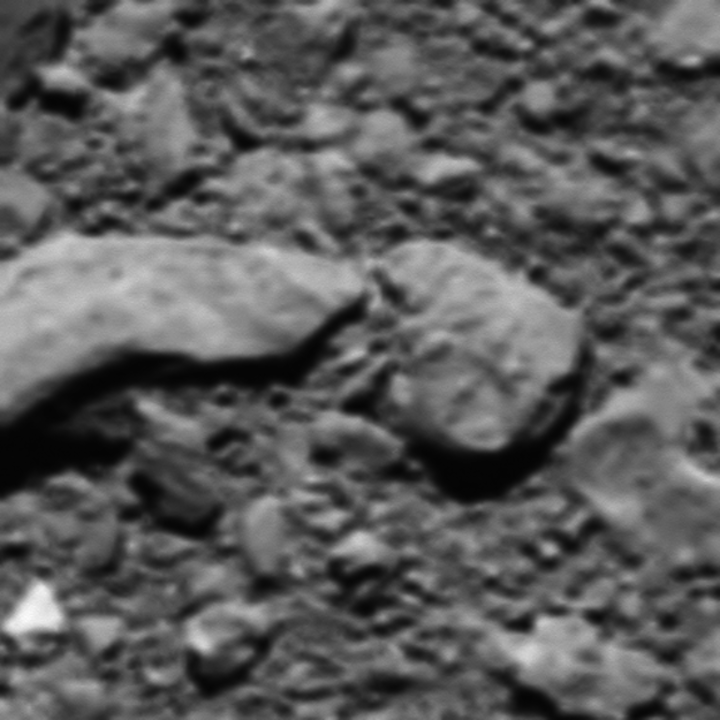
UNEXPECTED SURPRISE: A FINAL IMAGE FROM ROSETTA
Scientists analysing the final telemetry sent by Rosetta immediately before it shut down on the surface of the comet last year have reconstructed one last image of its touchdown site.
After more than 12 years in space, and two years following Comet 67P/Churyumov–Gerasimenko as they orbited the Sun, Rosetta’s historic mission concluded on 30 September with the spacecraft descending onto the comet in a region hosting several ancient pits.
It returned a wealth of detailed images and scientific data on the comet’s gas, dust and plasma as it drew closer to the surface.
But there was one last surprise in store for the camera team, who managed to reconstruct the final telemetry packets into a sharp image.
“The last complete image transmitted from Rosetta was the final one that we saw arriving back on Earth in one piece moments before the touchdown at Sais,” says Holger Sierks, principal investigator for the OSIRIS camera at the Max Planck Institute for Solar System Research in Göttingen, Germany.
“Later, we found a few telemetry packets on our server and thought, wow, that could be another image.”
During operations, images were split into telemetry packets aboard Rosetta before they were transmitted to Earth. In the case of the last images taken before touchdown, the image data, corresponding to 23 048 bytes per image, were split into six packets.
For the very last image the transmission was interrupted after three full packets were received, with 12 228 bytes received in total, or just over half of a complete image. This was not recognised as an image by the automatic processing software, but the engineers in Göttingen could make sense of these data fragments to reconstruct the image.
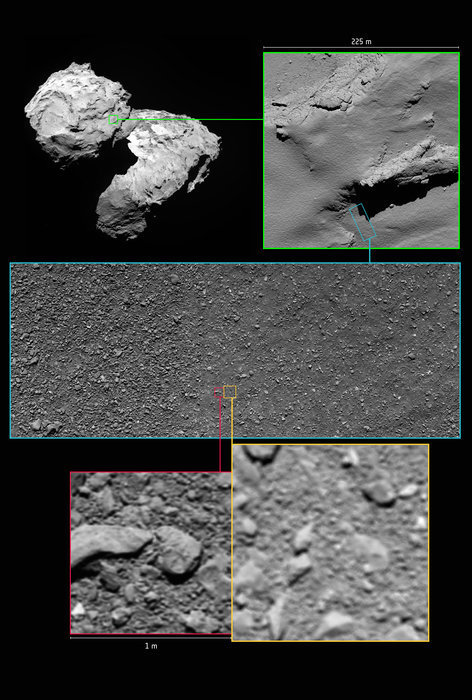
- Title Rosetta’s last images in context
- Released 28/09/2017 3:00 pm
- Copyright ESA/Rosetta/MPS for OSIRIS Team MPS/UPD/LAM/IAA/SSO/INTA/UPM/DASP/IDA
Annotated image indicating the approximate locations of some of Rosetta’s final images. Note that due to differences in timing and viewing geometry between consecutive images in this graphic, the illumination and shadows vary.
Top left: a global view of Comet 67P/Churyumov–Gerasimenko shows the area in which Rosetta touched down in the Ma’at region on the smaller of the two comet lobes. This image was taken by the OSIRIS narrow-angle camera on 5 August 2014 from a distance of 123 km.
Top right: an image taken by the OSIRIS narrow-angle camera from an altitude of 5.7 km, during Rosetta’s descent on 30 September 2016. The image scale is about 11 cm/pixel and the image measures about 225 m across. The final touchdown point, named Sais, is seen in the bottom right of the image and is located within a shallow, ancient pit. Exposed, dust-free terrain is seen in the pit walls and cliff edges. Note the image is rotated 180º with respect to the global context image at top left.
Middle: an OSIRIS wide-angle camera image taken from an altitude of about 331 m during Rosetta’s descent. The image scale is about 33 mm/pixel and the image measures about 55 m across. The image shows a mix of coarse and fine-grained material.
Bottom right: the penultimate image, which was the last complete image taken and returned by Rosetta during its descent, from an altitude of 24.7±1.5 m.
Bottom left: the final image, reconstructed after Rosetta’s landing, was taken at an altitude of 19.5±1.5 m. The image has a scale of 2 mm/pixel and measures about 1 m across.
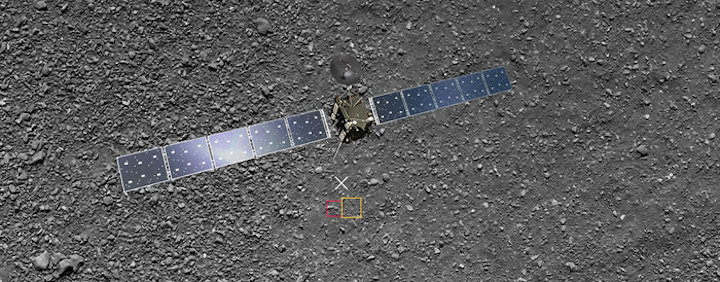
- Title Rosetta’s landing site to scale
- Released 28/09/2017 3:00 pm
- Copyright Image: ESA/Rosetta/MPS for OSIRIS Team MPS/UPD/LAM/IAA/SSO/INTA/UPM/DASP/IDA; spacecraft: ESA/ATG medialab
Description
In order to give a feeling of scale, this artist impression of the Rosetta spacecraft is superimposed on an OSIRIS wide-angle camera image of the region in which it landed on 30 September 2016. Also marked on the image are the approximate locations of the final two images taken by the spacecraft from around 20 m altitude. The cross indicates the estimated centre of touchdown of Rosetta.
The background image measures about 55 m across, while the final images are about 1 m across. For comparison, Rosetta measures 32 m from tip to tip, and its solar panels are a little more than 2 m high each.
Note that the positioning of the spacecraft on the image is not an accurate representation of the actual landing.

- Title Comet landing site
- Released 30/09/2016 1:10 pm
- Copyright ESA/Rosetta/MPS for OSIRIS Team MPS/UPD/LAM/IAA/SSO/INTA/UPM/DASP/IDA
- Description
Sequence of images captured by Rosetta during its descent to the surface of Comet 67P/C-G on 30 September.

- Title Rosetta’s final imaging sequence
- Released 15/12/2016 3:00 pm
- Copyright ESA/Rosetta/MPS for OSIRIS Team MPS/UPD/LAM/IAA/SSO/INTA/UPM/DASP/IDA
- Description
Imaging ‘footprints’ of Rosetta’s OSIRIS camera during the descent to the comet’s surface. A primary focus was the pit named Deir el-Medina, as indicated by the number of footprints indicated in blue. The trail of orange and red squares reflect the change in pointing of the camera towards the impact site, subsequently named Sais. The final image was acquired at about 20 m above the surface, and the touchdown point was only 33 m from the centre of the predicted landing ellipse.
Quelle: ESA
----
Update: 19.02.2019
.
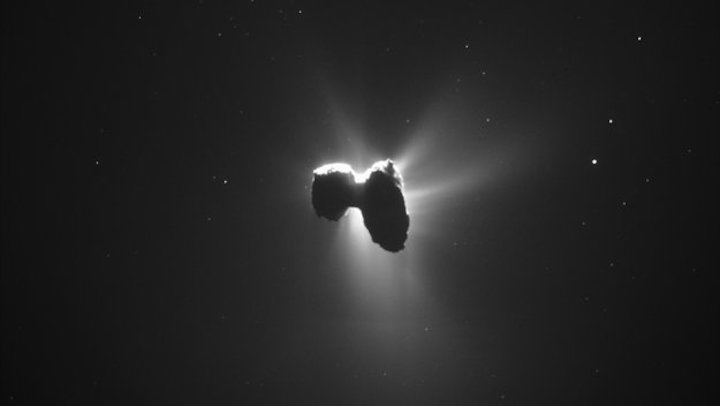
ROSETTA’S COMET SCULPTED BY STRESS
Feeling stressed? You’re not alone. ESA’s Rosetta mission has revealed that geological stress arising from the shape of Comet 67P/Churyumov–Gerasimenko has been a key process in sculpting the comet's surface and interior following its formation.
Small, icy comets with two distinct lobes seem to be commonplace in the Solar System, with one possible mode of formation a slow collision of two primordial objects in the early stages of formation some 4.5 billion years ago. A new study using data collected by Rosetta during its two years at Comet 67P/C-G has illuminated the mechanisms that contributed to shaping the comet over the following billions of years.
The researchers used stress modelling and three-dimensional analyses of images taken by Rosetta’s high resolution OSIRIS camera to probe the comet’s surface and interior.
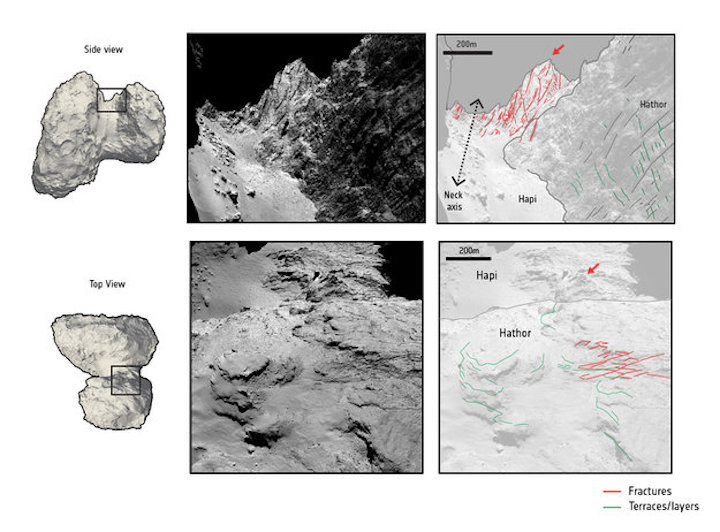
“We found networks of faults and fractures penetrating 500 metres underground, and stretching out for hundreds of metres,” says lead author Christophe Matonti of Aix-Marseille University, France.
“These geological features were created by shear stress, a mechanical force often seen at play in earthquakes or glaciers on Earth and other terrestrial planets, when two bodies or blocks push and move along one another in different directions. This is hugely exciting: it reveals much about the comet’s shape, internal structure, and how it has changed and evolved over time.”
The model developed by the researchers found shear stress to peak at the centre of the comet’s ‘neck’, the thinnest part of the comet connecting the two lobes.
“It’s as if the material in each hemisphere is pulling and moving apart, contorting the middle part – the neck – and thinning it via the resulting mechanical erosion,” explains co-author Olivier Groussin, also of Aix-Marseille University, France.
“We think this effect originally came about because of the comet’s rotation combined with its initial asymmetric shape. A torque formed where the neck and ‘head’ meet as these protruding elements twist around the comet’s centre of gravity.”
The observations suggest that the shear stress acted globally over the comet and, crucially, around its neck. The fact that fractures could propagate so deeply into 67P/C-G also confirms that the material making up the interior of the comet is brittle, something that was previously unclear.
"None of our observations can be explained by thermal processes,” adds co-author Nick Attree of the University of Stirling, UK. “They only make sense when we consider a shear stress acting over the entire comet and especially around its neck, deforming and damaging and fracturing it over billions of years.”
Sublimation, the process of ices turning to vapour and resulting in comet dust being dragged out into space, is another well-known process that can influence a comet’s appearance over time. In particular, when a comet passes closer to the Sun, it warms up and loses its ices more rapidly – perhaps best visualised in some of the dramatic outbursts captured by Rosetta during its time at Comet 67P/C–G.
The new results shed light on how dual-lobe comets have evolved over time.
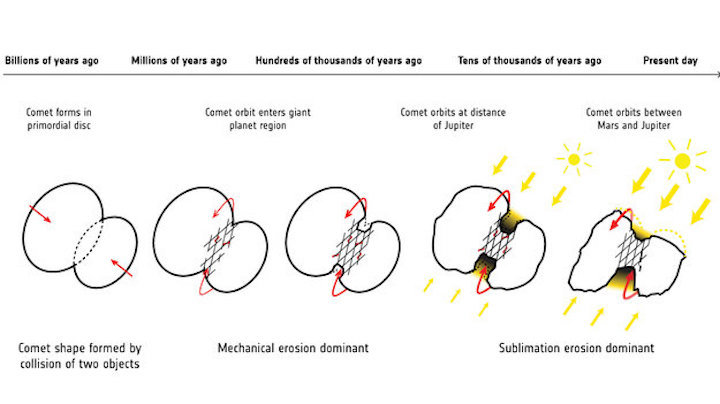
Comets are thought to have formed in the earliest days of the Solar System, and are stored in vast clouds at its outer edges before beginning their journey inwards. It would have been during this initial ‘building’ phase of the Solar System that 67P/C-G got its initial shape.
The new study indicates that, even at large distances from the Sun, shear stress would then act over a timescale of billions of years following formation, while sublimation erosion takes over on shorter million-year timescales to continue shaping the comet’s structure – especially in the neck region that was already weakened by shear stress.
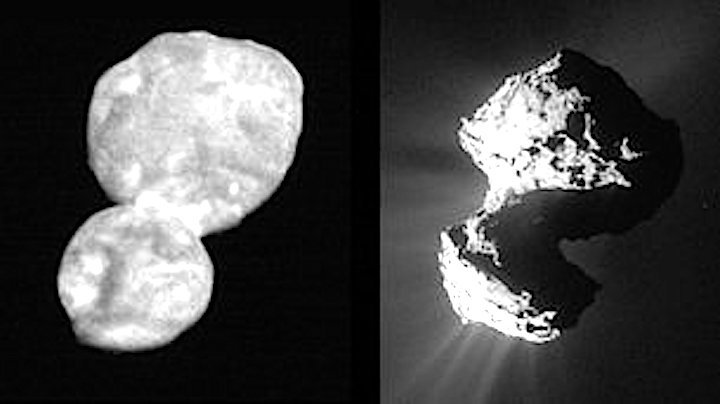
Ultima Thule vs Comet 67P/C-G
Excitingly, NASA’s New Horizons probe recently returned images from its flyby of Ultima Thule, a trans-Neptunian object located in the Kuiper belt, a reservoir of comets and other minor bodies at the outskirts of the Solar System.
The data revealed that this object also has a dual-lobed shape, even though somewhat flattened with respect to Rosetta’s comet.
“The similarities in shape are promising, but the same stress structures don’t seem to be apparent in Ultima Thule,” comments Christophe.
As more detailed images are returned and analysed, time will tell if it has experienced a similar history to 67P/C-G or not.
“Comets are crucial tools for learning more about the formation and evolution of the Solar System,” says Matt Taylor, ESA’s Rosetta Project Scientist.
“We’ve only explored a handful of comets with spacecraft, and 67P is by far the one we’ve seen in most detail. Rosetta is revealing so much about these mysterious icy visitors and with the latest result we can study the outer edges and earliest days of the Solar System in a way we’ve never been able to do before.”
Quelle: ESA
